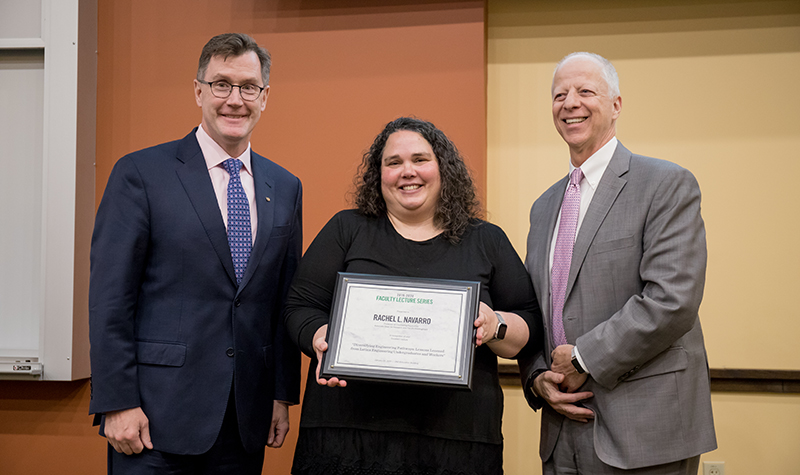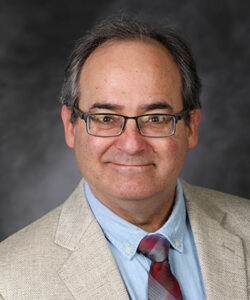Closing the Latinx achievement gap in engineering
It can be done, suggested Professor Rachel Navarro, in presenting her research as part of the UND Faculty Lecture Series

The nation’s largest nonwhite ethnic group — and one of the fastest growing ethnic groups — is sorely underrepresented in engineering schools.
Moreover, when Latinx students do pursue engineering degrees, they take much longer to graduate and drop out at higher rates than do whites.
Why?
Rachel Navarro, professor of counseling psychology at UND, researches that question — and is finding answers. North Dakotans should take note, because the Latinx population here grew by 135 percent between 2008 and 2018, jumping from 12,600 to 29,500. That was the fastest growth rate of any state.
Navarro, who’s also associate dean for research and faculty development in UND’s College of Education and Human Development, described her research and findings to a UND audience on Jan. 22. Navarro’s talk was part of the Faculty Lecture Series, a University project that started in 1954 and that “showcases the scholarly research of faculty selected across the disciplines,” as the series’ Web page notes.
For more than 10 years and with the help of several National Science Foundation and other grants, Navarro and her colleagues have researched why so many fewer Latinxs become engineers than their share of the population would suggest.The numbers are stark: Despite the fact that Latinxs comprise 18 percent of the U.S. population, they are 13 percent of all undergraduate engineering majors and earn 11 percent of undergraduate engineering degrees, Navarro told the audience.
Furthermore, 30 percent of Latinx engineering students earned their degrees in four years, compared with 44 percent of their white peers.
And some 47 percent of Latinx engineering students either take longer than six years to earn their degrees or never do so at all. The comparable figure among white engineering students is 36 percent.
Those figures mean high numbers of Latinx engineering students graduate with lots of debt — or much worse, leave college with high debt and no degree.
As disturbingly, the trends represent a failure of the American educational system to tap an obvious source to fill a vital workforce need. “There is a global demand for talented and skilled scientists and engineers,” Navarro told the audience.
“According to the National Academies of Science, Engineering and Medicine, we’re facing a shortfall of nearly 3.4 million skilled technical workers by 2022.”
And given the Latinx population’s status as one of the fastest-growing U.S. communities of color, “if you want to actually grow your enrollment, that’s the community you really need to target.”

‘How will they learn best?’
Navarro used both her own experience and her research findings to explain how that might be done.
The daughter of a Czechoslovakian-Irish mother and a Puerto Rican father, Navarro’s Latinx heritage prompted her interest in boosting Latinx students’ college success. “Every step of the way on my educational journey, I’ve noticed fewer and fewer people who look like me,” she told the audience.
“And it makes me wonder, what helped me succeed? … Education really is freedom; it really did change the course of my life. And I want to provide that privilege to other people as well, because if we take education into our own hands, we can use it to change the world.”
With that in mind, Navarro came upon a quote from educator Jaime Escalante of “Stand and Deliver” fame. The quote was, “Ask ‘How will they learn best,’ not ‘Can they learn.’” And Navarro, with her research colleagues at UND, University of Missouri, University of Denver and Oklahoma State University, has spent the past decade answering — with social-science rigor — Escalante’s question as it applies to Latinx engineering students.
“We call our study ‘Persistence in Engineering,’” Navarro said in her lecture. “Our studies are theoretically grounded, and all of our constructs are built on valid and reliable measures. And we’re now one of the largest educational-retention projects with a specific underrepresented minority group that the NSF is sponsoring to try to find out what works.”
The results, published in peer-reviewed periodicals such as the Journal of Vocational Behavior and Journal of Counseling Psychology, are giving engineering deans and faculty specific tools to boost Latinx students’ odds of success.
For example, here are quotes from a 2019 paper in the Journal of Counseling Psychology that Navarro was lead author on, and that she described in her lecture.
As the study of 1,335 engineering students showed, “engineering self-efficacy plays a central role in the promotion of engineering academic engagement, academic satisfaction and intended persistence and should be a key mechanism in any intervention targeted at broadening participation in engineering.”
Engineering self-efficacy is a student’s belief that he or she can successfully navigate the curriculum and become an engineer. So, the more schools help students master content and develop skills via internships, research opportunities and other confidence-building experiences, the more successful those students will be.
Furthermore, “interventions designed to enhance self-confidence in successfully completing engineering tasks may be particularly important for Latina/os at predominantly white institutions,” where those students are a minority and must cope with the stresses that accompany that status.
“Such interventions could occur during college, but also could happen during students’ K-12 educational experiences,” the study notes.
“Furthermore, it would behoove counseling psychologists and engineering administrators, faculty, and advising staff to focus on strengthening Latina/o engineering undergraduates’ social support,” using strategies such as peer or faculty mentoring programs.
Understand, it’s one thing to say confidence plays an especially important role for Latinx engineering students at predominantly white institutions. It’s another thing to document that relationship; and along with many other key findings, that’s exactly what Navarro and her colleagues have done.

Mentorship matters
Asked if the Latinx engineering students’ experiences mirrored her own college career in psychology, Navarro said they did. “I mean, the reason that I’m standing here is because of the mentorship that I received,” she said.
“If I hadn’t had it, I wouldn’t be here. And so, a lot of the conversations about the students’ experiences with mentorships and other supports really rang true for me as well.”
Navarro is a “triple threat” at UND, said Tom DiLorenzo, provost and vice president for academic affairs at the University, in thanking her to the audience after the lecture.
“She’s a wonderful teacher,” he said. “She does phenomenal research; I mean, I recognize those journals where she’s been published. They’re the best of the best.
“And her service is unbelievable as associate dean for research and faculty development, among other titles. She’s doing incredible work.”
DiLorenzo closed by inviting Navarro to apply her research to the engineering school at UND. “My guess is the provost, and maybe the president” — DiLorenzo gestured to incoming UND President Andy Armacost, who was in attendance — “would be happy to talk with you about this. How can we take this wonderful conceptual work and integrate it into what we do, and figure out ways to support that effort within your department and across the university?
“We can’t wait to get your phone call!” DiLorenzo said, to the audience’s laughter and applause.



